Understanding positional words is quite a long process. It takes most children a while to first comprehend the terms, and then longer again to start to use the words themselves. Having worked as a preschool teacher for many years, I have lots of tricks and games up my sleeve to get them going with this key skill. But first, what exactly are positional words?
Positional words (or positional language) are words and phrases that describe the position of people or objects. Examples would be the words ‘in’, ‘under’, and ‘over’, or the phrases ‘on top of’, or ‘next to’. An example of a sentence containing positional words would be ‘The puppet is on the castle.’
That’s the short answer, but there is quite a bit more to it. What are the key words that you need to teach young children? What order should you go in? And, most importantly, what are the best activities to teach it? (And I’ve got the 14 top games for you shortly)
This article answers all of these questions and more…
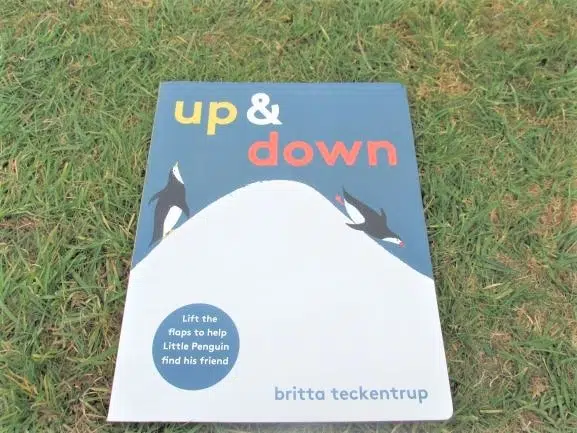
What Positional Words Are
Quite simply, positional language is how to describe the position of things.
It is something that children will encounter on a daily basis in play-based learning and also in any structured games or activities. These terms take a while for most of them to get their heads around.
The most common positional language words that they will encounter are probably:
- In
- Under
- On top
- Over
- Beside
- Next to
- Inside
- Outside
- Beneath
- Between
- Right
- Left
Of course, there are more, but start simple. Many children just ‘pick up’ how to use these words in normal everyday life, but most are helped by some focused learning experiences.
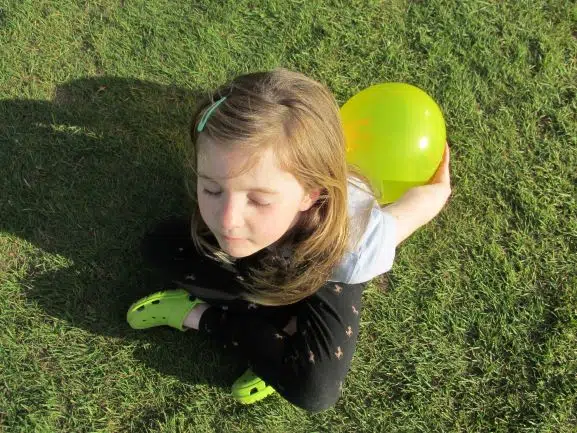
Some Examples Of Positional Words
Here are a few example sentences of positional words in action:
The cat sat on the bed.
The bird flew over the roof.
The dolphin swam under the boat.
The boy climbed inside the box.
The knight sat beside the princess.
What Order Should You Teach Positional Words?
There are certainly some words that are simpler and much younger children can understand. Then there are words that will be picked up later on.
The Simplest Stage
The simplest positional language is words such as:
in, on, under
Slightly More Complex Language
Some examples are probably:
Inside, outside, over, on top, next to
More Complex:
In between, beneath, beside, around, forwards, backwards, sideways
Most Complex:
Left, right
Left and right are the hardest of these concepts to understand, and many children take several years to master this quite abstract concept.
What Age Can Children Begin Learning Positional Words?
Children will begin to understand positional language from being babies, as it crops up so much in day-to-day life.
The time to introduce it in more structured activities is probably around the age of 4-5.
Right, now that you definitely know what it is, let’s take a look at some great ways to teach it starting with books…
Books To Teach Positional Words
I would say the very best way to teach positional language outside of play-based learning is through books. There are many excellent ones for this purpose.
I would particularly choose:
- A book that doesn’t have many words. This really helps to get the message across in a clear and concise way
- A book that you can bring to life with movement
Here, then, are my favorite positional language picture books:
1. Rosie’s Walk
This is definitely my number one choice! It is so simple, and even very young children, probably from about 18 months upwards can start to appreciate this book.
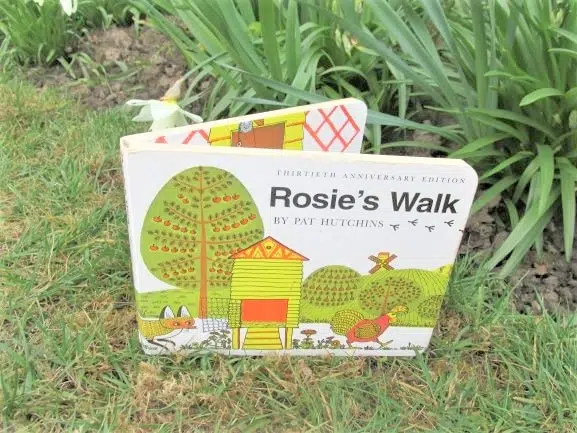
The whole book is basically one long sentence of about 80 words. However, despite being so short, it manages to pack in all of the following positional words: across, around, over, past, through, beside, under
This book is brilliant to bring to life with actions! Get the children to stand up and really ‘live’ the positional words. For example, for the word ‘through,’ throw both arms forward at the same time. Making learning multisensory in this way really helps children to ‘get’ the concept.
2. Where’s Spot?
This is another super simple one. Basically, Spot has gone missing before lunchtime. Where can he be?
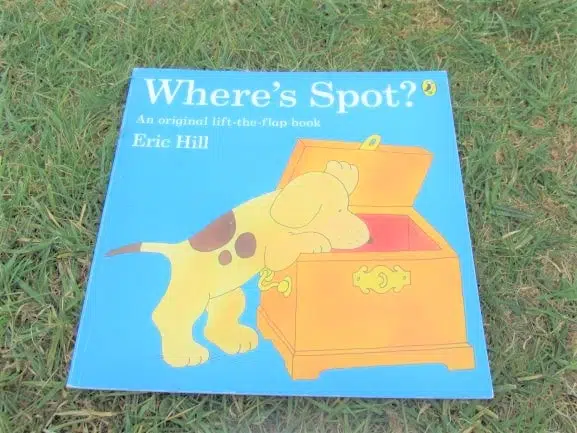
This book really repeats some key words like ‘in’ and ‘under’. Repetition is good for any concept like this! The more children have things repeated in a fun way, the more they will understand.
This is another excellent book because it has very few words in it. The fewer the better when you are trying to teach maths concepts!
I have also had a go of this book where everyone has a toy of some sort in their hands. When you read a page, for example ‘Is he under the rug’ I get the children to put their toy ‘under’ an imaginary rug. The more you can act out these words in physical ways the better.
3. Britta Teckentrup – Up and Down
This book is more complex. I would definitely start with Rosie’s Walk or Where’s Spot, but this is an excellent next step.

The book follows some penguins that go on an adventure. There are all sorts of math words in this book, and it particularly focuses on opposites. There are probably close to 20 positional language words in this book, so great for children of different ages.
4. Bear Hunt
This one is slightly longer than the others, but it is a classic book and one that pretty much all children really love.
The big words in this are: over, under, through
The beauty of this book is the repetition. Children get to say the key positional words over and over. This really helps them internalize their meaning.
This book also has a great rhythm. It is great all chanted together, with all the children standing up, marching, and acting out the words as you go.
If you want to see a fantastic rendition of this book read by the author then check this video out:
• Outdoor Maths Games – 50 Ideas That Really Work!
Activities To Teach Positional Words
There are definitely lots of super games and activities that you can do to support the learning of positional language. These games act as a way of modelling and practising the language, that the children can then use independently in their play.
5. Puppet In A Castle
You can use any toy or puppet for this.
All you need to go with it is some kind of thing for the puppet to explore. It could be a doll’s house, a castle, or even just a box.
Model it first. Show them what it looks like when the puppet is ‘on’ the castle, ‘in’ it, ‘beside’ it, and so forth.
Then let the children have a go. One at a time a child holds the puppet as you give directions where to put it.
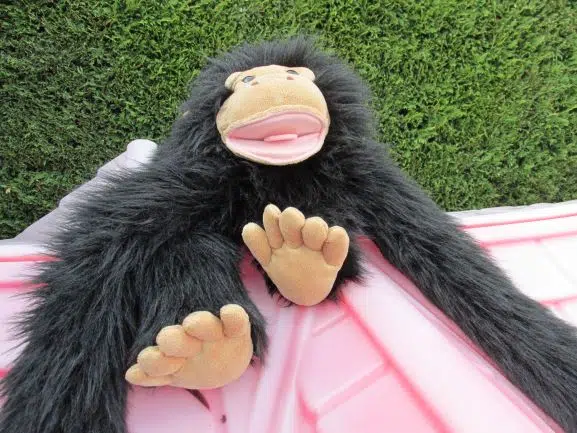
Puppets are a fantastic way of capturing children’s attention. To find out 22 brilliant puppet activities across the whole curriculum, check this out.
6. Blind Man’s Buff
This is a bit trickier. Have one child who is blindfolded. Have them stand in the middle of a circle.
Have some kind of treasure or goal on the floor – it could be a rubber spot for example. One child is going to try to direct the child to get to the spot and stand on it.
They give directions like ‘go forward, backwards, sideways’ etc
The child moves around and tries to get to the goal. For many more activities like this, check out these 21 fantastic circle time games.
7. Pin the Tail On The Donkey
This is a bit harder again, and really works on those trickier concepts of ‘left’ and ‘right’.
Have a blindfolded child and a large picture of a donkey. Give the child a pretend donkey tail with a large piece of tack on it. The child has a partner, and they try to give them directions like ‘left’, ‘right’, ‘up’, and ‘down’, to get them to put the tail in the right place on the donkey.
8. Treasure Hunt
This is good to do with children who are beginning to read sentences.
You can do it as a large group, or they could do it by themselves in teams. Have some clues written that you place in key spots either inside or outside. They could say things like ‘go to the sink’. On the sink, there will be another clue that might say ‘look under the big chair.’
Basically use lots of positional language and lead the children to some kind of treasure or prize.
9. Beebot
Beebots are little robots that look a bit like bees. You program them to move in different directions. They are good to use on big pieces of paper with different maps and other things drawn on them.
Good for thinking about direction, and children will be talking and experimenting with language as they do it.
10. Positional Language Pictures
Target words – any you like
Give the children a piece of paper each. What you are going to do is get them to draw a picture and put details into the image that require them to think about positional language.
An example might be the following:
- Draw a tree
- Put a cloud over the tree
- Put a bird in the tree
- Draw a boy under the tree
- Draw a girl beside the boy
- Draw the sun in the sky
- Draw a plane next to the sun
You can do this in different ways. For younger children, it is probably best to do the activity verbally and just get them to draw the picture.
Older children, or those that are confident readers, could get a set of written clues, and try to follow them to create the picture.
11. Simon Says
This is another old classic game, that can be adapted really well to teach positional words.
In this ‘Simon’ (usually the adult) will say things like ‘Simon says put you hand under your chin. Put your hand on top of your head.’
Other ideas could be:
‘Simon says put one hand beside the other.’
‘Simon says put one hand in the above your head.’
‘Simon says put one hand under your armpit.’
12. Cut And Stick
The idea of this is to have some pictures that the children can cut out. It could, for example, be some farm animals.
Say things like ‘Stick a cow on your picture. Put a pig next to the cow. Put a sheep under the cow.’
Just keep going like that. Great for their fine motor and cutting skills, as well as being excellent for their knowledge of positional words.
Songs To Teach Positional Language
Songs are great for teaching many maths concepts. Making learning multisensory really helps the process, as well as just making it fun.
Some excellent songs to try include:
13. The Hokey Cokey
Great for words like ‘in’, ‘out’, ‘around’, ‘left’, ‘right’.
You must know the lyrics to this one! But if not, here is how it goes…
Stand in a circle and sing:
You put your left hand in,
You left hand out,
In, out, in, out, you shake it all about!
You do the hokey cokey and you turn around
That’s what it’s all about!
For the chorus all hold hands and go towards the centre of the circle as you sing the ‘Ohh!’ word, before going back out ready to come back in:
Ohh! Okey okey cokey (x3)
Knees bend, arms stretch, rah! Rah! Rah!
Other lyrics include:
You put you right hand in…
You put your left leg in…
You put your right leg in…
You put your whole self in…
As well as begin excellent for the ‘in’ and ‘out’ words, this is possibly the best way of teaching ‘left’ and ‘right’.
14. Grand Old Duke Of York
Fantastic for words like ‘up’, ‘down’
Once again, you must know this one, but just in case you don’t, here are the lyrics. Stand in a circle and sing:
Oh, the grand old Duke Of York
He had ten thousand men,
He marched them up to the top of the hill
And he marched them down again.
And when they were up they were up,
And when they were down they were down,
And when they were only halfway up
They were neither up nor down.
Both of these songs can be done with a parachute, to turn them into excellent cooperation experiences. If you want to check out some more excellent preschool songs that you can do with a parachute then try these.
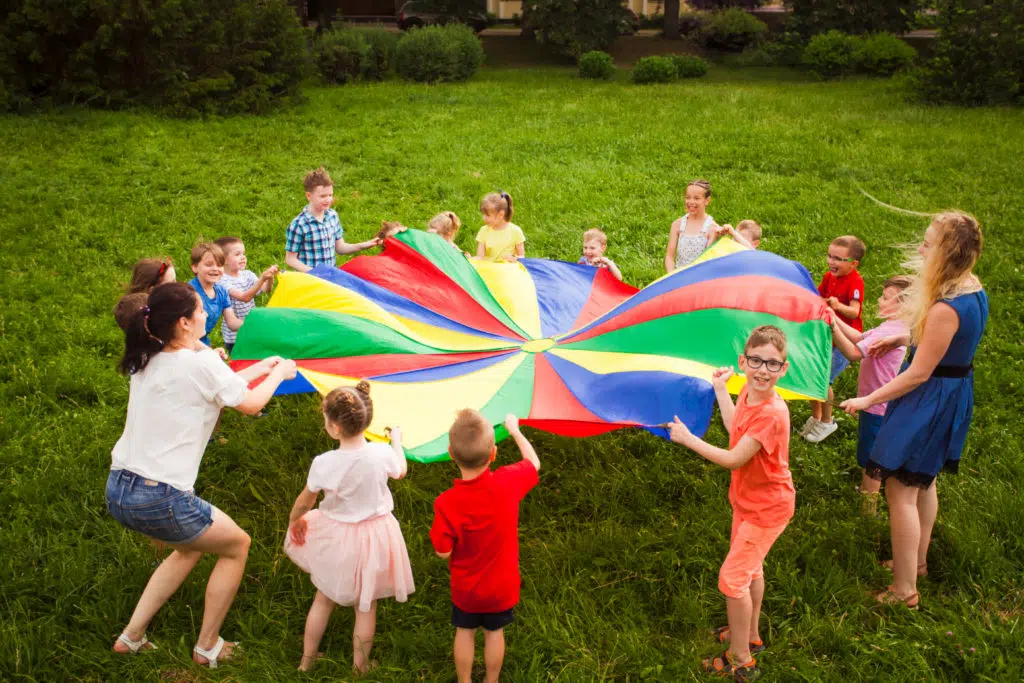
Top Tips For Teaching Positional Words
- Make it real!
- Bring it to life with simple stories that really exemplify what the words mean
- Use puppets and toys in different scenarios
- Start with the very simplest words and expand outwards
- Use it lots in play-based learning to add context (this will usually happen anyway without you thinking about it)
Conclusion
Positional language takes a long time for many to get to grips with, but bringing it to life with stories, songs and games really helps the process.
If you’ve found this article useful, then why not take a look at one of these:
